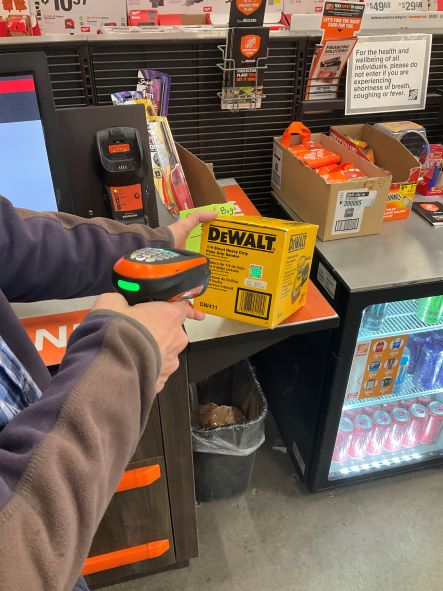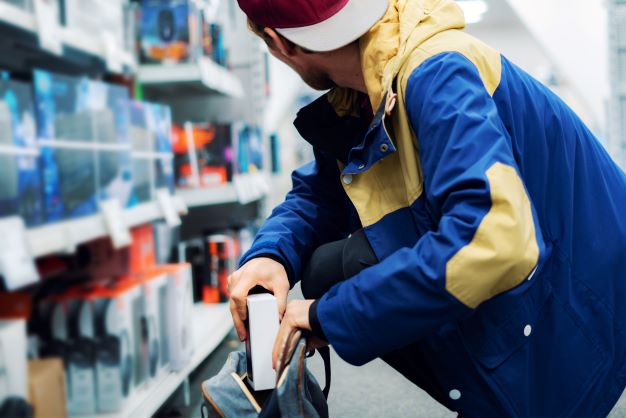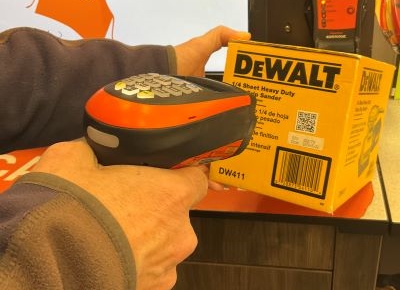Serial Number Capture with a Single Scan: Increasing Satisfaction and Reducing Fraud
By Dr. Ron Lembke, University of Nevada
Retail Fraud has been on the minds of many people recently, and not only reverse logistics professionals.
In this article, we will explore how 12N Codes (developed by the RLA Standards Committee) make it possible to capture a serial number with a single scan at the point of sale, and how this can potentially help to improve customer satisfaction, while also fighting retail fraud, counterfeit returns and online sales of stolen goods. We will also introduce the concept of a Universal Serial Number.
Organized Retail Theft
One of the retail stories that gained a great deal of attention in 2021 was a series of high-visibility retail theft incidents, often referred to as “mass robberies,” also referred to as “smash and grab” robberies.
On November 24, nine people were arrested in connection with over $1 million in theft from high-end shops in Northern California, including widely covered robberies at Louis Vuitton and Nordstrom (KTLA, 2021; ABC7, 2021; Elinson, 2021; Hernandez, 2021).
Although the mass robberies, or smash-and-grab robberies generated a lot of media attention, they are far from representing the largest amount of retail theft. The National Retail Federation estimates that Organized Retail Crime (ORC) costs retailers an average of $700,000 per $1 billion in sales.
Protecting Against Retail Theft
One common response to retail theft is to make mass robberies harder by hardening stores. This involves a number of practices, including increased use of anti-theft devices, and placing more products inside locked cabinets and behind bars and other anti-theft devices.
Although such efforts may discourage organized retail theft, they have definite negative customer service consequences. Anti-theft devices must be removed by personnel at point of sale. Most inconvenient, however, is the products locked in cabinets and behind bars. Any time a customer wants to purchase, or even look at, such a product, they have to have an employee unlock the product. Given the labor challenges facing the retail industry, finding an employee is increasingly difficult, which compounds the negative service impact of the anti-theft practices.
Single Scan Serial Number Capture with 12N
The 12N barcode standard was created by the RLA Standards Committee, and approved by the ANSI committee MH10.8.2 in 2016. The 12N standard allows a company to place as many pieces of information as they desire inside of a single QR code or Data Matrix code. The Standards Committee is currently moving with Tier 1 companies on a number of pilot projects to demonstrate the real-world effectiveness of 12N codes.
One of the most exciting retail uses for 12N codes is in allowing retailers to capture serial numbers at the point of sale, in a single scan. Various solutions have long existed that allow serial numbers to be captured at point of sale, but they have always required additional labor for a second scan.
A 12N code allows a manufacturer to place a single QR code on product packaging that contains both the UPC and the product’s serial number. The 12N code could also contain other product information, such as links to product information, lot codes, date codes, RoHS/WEE information, or any other information the retailer or manufacturer desire. Additionally, any or all of the fields can be encrypted, for additional security.
Serial Number Capture of Any Serialized Device
With 12N codes, PoS SN capture is available with any serialized product. With current solutions, additional labor costs are required for PoS SN capture. This additional cost means it only makes economic sense to capture the serial number of very high-value products, or for extended warranties.
But with 12N, and a single scan, the serial number of every single device can be captured, regardless of the price point.

Customer Loyalty & Experience with Serial Number Capture
Capturing the serial number for every serialized device that is sold offers many benefits to the retailer and manufacturer, as described below. But it also offers many opportunities to improve service for the customer.
If the customer enters their loyalty club information at the PoS terminal, via phone number or a loyalty card, the retailer already knows the identity of the customer. By recording the serial number of the device, the SN can be recorded to the consumer’s account, and the serial number can be stored in the customer’s purchase history.
Even if the customer does not provide account or loyalty information, the SN can be associated with the customer’s credit card number, which can provide many of the same benefits, if the customer has a question about a warranty claim, or needs assistance finding replacement parts or accessories.
By capturing the SN at PoS, this provides the customer with many other valuable opportunities:
- Warranty registration can be automated, if customers so choose, because the SN has already been captured.
- Similarly, purchasing extended warranties is a simpler, easier process, because the SN is known, and the point-of-sale extended warranty process is simplified.
- Warranty service is simplified, because the SN is already associated with the customer
- Purchasing supplies or consumables (toner, drill bits, filters, cartridges, oil, etc.) is simplified
- The retailer or manufacturer can easily provide targeted discounts on accessories and consumables, or service or replacement products.
Reducing Returns Fraud with Serial Number Capture
In addition to the many benefits to customers of point-of-sale serial number capture, the process also provides many benefits to retailers and manufacturers, some of which have just been described.
But one of the greatest potential benefits of PoS SN capture is the opportunity to significantly reduce returns fraud. No perfect solution will ever eliminate retail theft, but PoS SN capture offers significant benefits.
If a retailer has recorded the serial number of every serialized device that is sold, the retailer can easily very whether a certain item was purchased from that retailer, when, and at which location.
If the retailer has information on every unit they have sold, and a criminal attempts to return an item that was stolen, the retailer can inform the customer that this device was never sold by the retailer. If the item is one that is only sold by that retailer, the retailer can inform the individual that the device has been stolen.
Additionally, if an item is purchased, but a fraudulent return occurs, such as replacing the contents of the packaging with a lower-value item, this also can be addressed when it is discovered. By looking at the sales history of that SN, the retailer can look back and see who purchased and returned the item.
Once criminals become aware of the retailers’ new ability to fight these kinds of fraud, one would expect a significant reduction in these fraudulent activities.
Reducing Fraudulent Online Sales
There have been numerous articles written about unethical individuals or companies selling stolen products through online marketplaces. If a serialized item is stolen, once the retailer realizes it has been stolen, the serial number could be added to a list of known stolen items.
Potentially, internet marketplaces could require sellers to enter the serial numbers of the items they are selling.
The serial numbers could be hidden from the public, for security reasons. But the seller could display a certificate showing the item was verified as legitimately purchased. Once a customer purchases the item, they could be shown the serial number used in the listing, and once they receive the item, they could verify that the serial number on the item they received matches the number shown in the listing. This would prevent sellers from using the serial number from a legitimate purchase, and then sending the unsuspecting customer the serial number from a stolen item.
Additionally, a manufacturer could also provide the public with the ability to enter a serial number and verify that an item they are considering purchasing was, in fact, legitimately purchased by the seller.
Stolen Goods Recovery
The final way that PoS SN capture using 12N codes can aid retailers and manufacturers is in the recovery of stolen goods. Sadly, it is a rather common occurrence that police recover a significant number of apparently stolen products, but cannot easily establish where the products were stolen from.
With PoS SN capture, a retailer can easily verify whether any recovered devices match the serial numbers of devices formerly in their inventory.

Universal Serial Numbers
One additional way to facilitate the recording of serial numbers is through the use of Universal Serial Numbers. The Standards Committee of the RLA has been working with OBADA Foundation (Open Blockchain for Asset Disposition Architecture). OBADA has developed a simple process for creating a Universal Serial Number, or USN.
Every company has its own process for creating a serial number, and no organization will ever be able to convince everyone to use the same format or character set. But the USN concept avoids that problem.
To create a USN, the manufacturer’s name, the serial number, and the product model information are all written out, end-to-end. This string of characters is then fed into an algorithm known as the SHA-256 Hashing Algorithm. This algorithm returns a 64-character string, a combination of numbers and upper- and lower-case letters. The output appears to be random, but it is not random, but a very complicated process. Any two people entering the same exact characters will get the exact same output.
The last 8 characters from this string are used as the USN. Because of the apparently (but not actually) random nature of the process, it is possible that those 8 characters may have been used as a USN previously. In this very rare event, 12 characters are used, to find a unique USN.
Because USNs are so short, and universally unique, they allow a very simple way to generate a serial number that can be used for literally any serialized item or component, from a microprocessor to a vehicle, or anything in between.
Summary
In summary, recording serial numbers at the point of sale provides benefits to customers by making it easier for them to access information about their purchases, return items, purchase extended warranties, place warranty claims, purchase parts and accessories, and purchase replacement items. But point of sale serial number capture has always required additional labor and expense.
The use of 12N QR codes or Data Matrix codes can allow a retailer to capture the serial number with the same scan that is used to read the UPC and purchase the product. By allowing SN capture in a single scan, it dramatically reduces the cost of capturing the SN at point of sale. The serial number of any serialized device can now be captured with a single scan.
In addition to benefits to customers, capturing the serial number in a single scan provides many benefits to retailers and manufacturers. It offers many benefits for reverse logistics and fraud prevention. When the serial number of every unit sold has been logged, any attempts to return stolen items can easily be thwarted. In addition, it can greatly assist in proving ownership of any stolen items recovered by law enforcement.

References
ABC7, 2021, “Caught on Camera: Thieves steal $100k in Louis Vuitton goods in brazen grab-and-run heist,” https://www.youtube.com/watch?v=Iqnu84WpVFE, accessed 2/11/2022.
CBSLA, July 20, 2021, “2 Mean Caught on Camera In Brazen Daylight Theft from Granada Hills TJ Maxx,” https://losangeles.cbslocal.com/2021/07/20/caught-on-camera-granada-hills-tj-maxx-shoplifting/ accessed 2/11/2022.
Elinson, Zusha, Dec 13, 2021, “Flash-Mob Thefts Planned on Snapchat and Other Apps, Police Say,” Wall Street Journal, https://www.wsj.com/articles/snapchat-and-other-apps-were-used-to-plan-flash-mob-thefts-police-say-11639400403?mod=Searchresults_pos9&page=1
Hernandez, Joe, “80 people stormed a California Nordstrom store and stole merchandise,” https://www.npr.org/2021/11/21/1057817911/80-people-california-san-francisco-nordstrom-organized-theft
KTLA, “9 charged in $1-million theft wave of luxury stores in San Francisco,” https://ktla.com/news/california/9-charged-in-1-million-theft-wave-of-luxury-stores-in-san-francisco/ accessed 2/11/2022.
NRF, 2020, “NRF 2020 Organized Retail Crime,” https://nrf.com/research/2020-organized-retail-crime-survey
Waugh, Shemar, aka marleyshow1, December 20, 2021, “Gots to be more careful” https://www.tiktok.com/@marleyshow1/video/7043964028519091502?is_copy_url=1&is_from_webapp=v1
Snopes, “Can You Exchange Used Candles at Bath & Body Works?” September 21, 2021, https://www.snopes.com/fact-check/bath-body-works-candles/
 Dr. Ron Lembke
Dr. Ron LembkeDr. Ron Lembke, is the Chair of the Managerial Sciences Department in the College of Business at the University of Nevada, Reno, and an Associate Professor of Operations Management. Ron has written extensively on Reverse Logistics, and is co-author, with Dale Rogers, of “Going Backwards: Reverse Logistics Trends and Practices,” the most widely cited text on the subject.
He is the Chair the Standards Committee of the Reverse Logistics Association, and the author of the 12N Data Standard, which standardizes data labels and allows companies to include up to 3,000 characters in a 2D barcode that can be read by anyone, or encrypted for privacy. He also serves on the Material Handling Institute’s MH 10.8 Standards Committee, and the US Post Office’s Postmaster General’s Mailers Technical Advisory Committee. He holds a PhD in Industrial Engineering and Management Science from Northwestern University and a BA in Mathematics with a Computer Science concentration from St. Olaf College in Northfield, MN.